The Best 10 Alternatives to Threatlocker (+ Pricing & Reviews)
Twingate Team
•
Jul 27, 2024

ThreatLocker offers a Zero Trust Endpoint Protection Platform that includes application allowlisting, ringfencing, network control, and storage control. While ThreatLocker provides robust cybersecurity solutions, it may not be suitable for every organization. This article explores how Twingate enhances secure access for distributed workforces.
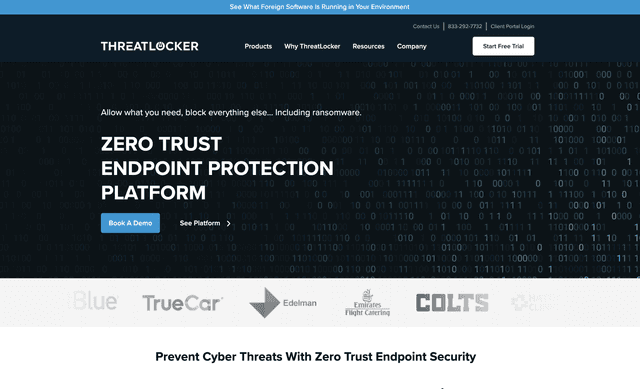
10 Alternatives to Threatlocker
1. Vipre EDR
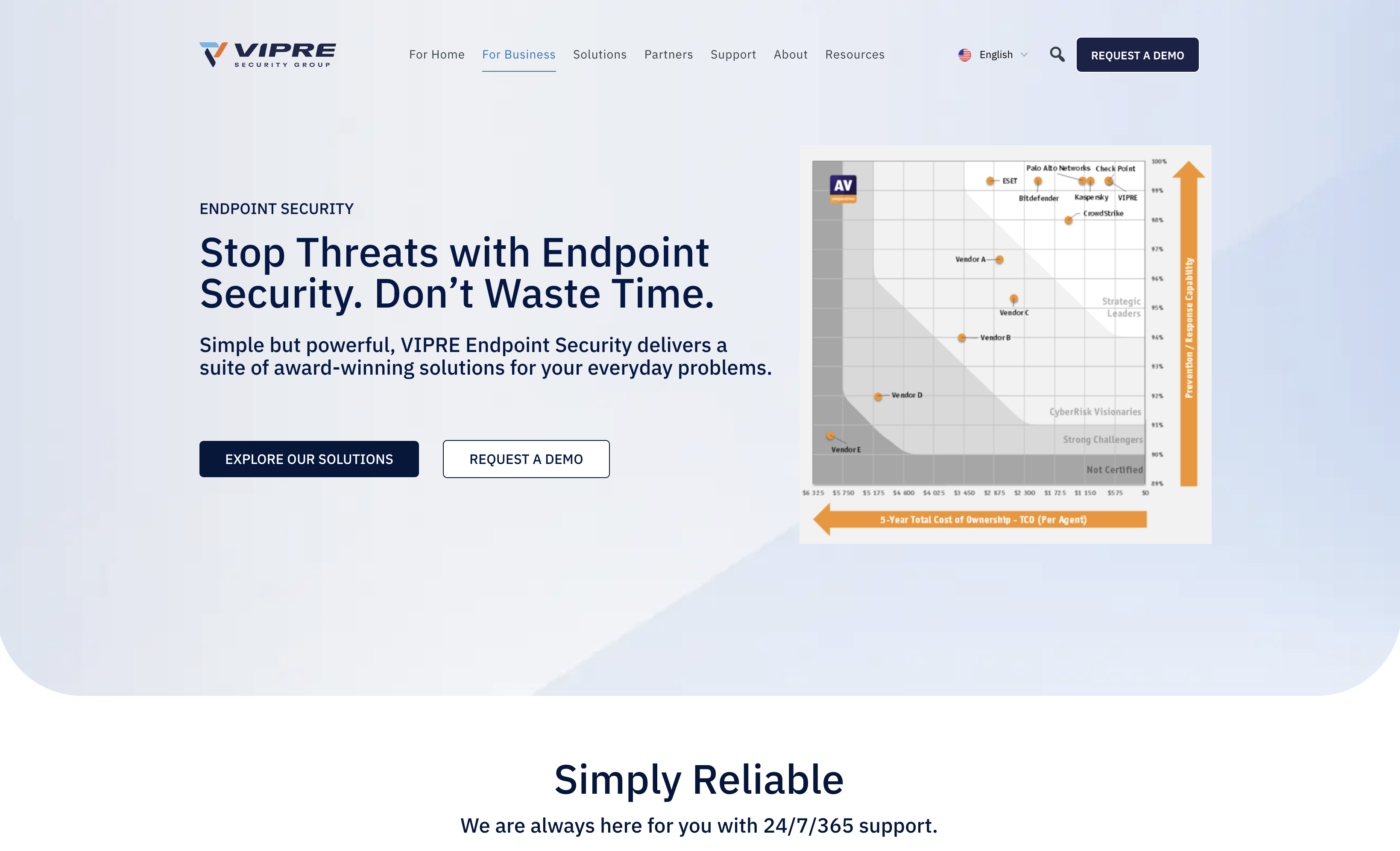
Vipre Endpoint Detection and Response (EDR) is a cybersecurity solution designed to efficiently stop threats and provide comprehensive protection. It emphasizes simplicity and power, offering award-winning security for everyday challenges. Vipre EDR is easy to install and use, making it accessible for businesses of all sizes.
Vipre EDR Pricing
Vipre EDR's pricing is not public. Contact their support for more info.
Vipre EDR Reviews
Vipre EDR has an overall rating of 4.5 out of 5 stars based on 200 reviews. Users appreciate its ease of use and robust protection. Check out more of our reviews here!
Pros and Cons of Vipre EDR
Pros:
VIPRE EDR is easy to install and use, making it accessible for businesses of all sizes.
It offers robust ransomware prevention and rollback, utilizing real-time behavior monitoring and AI.
Provides a complete view of threat behavior, enabling rapid remediation and centralized monitoring.
Cons:
Limited user reviews make it difficult to gauge overall customer satisfaction and performance.
Some features are only available on higher-tier plans, potentially increasing costs for full functionality.
While powerful, the product may require additional training for optimal use by non-experts.
2. Huntress Managed EDR
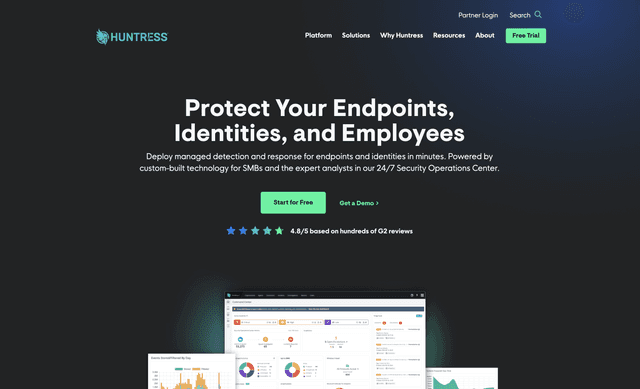
Huntress Managed EDR is a cybersecurity solution tailored for small and medium-sized businesses. It offers comprehensive endpoint detection and response, ensuring full visibility and rapid threat mitigation. With 24/7 SOC support and smart filtering technology, Huntress aims to provide robust security without overwhelming system resources.
Huntress Managed EDR Pricing
Huntress Managed EDR's pricing is not public. Contact their support for more info.
Huntress Managed EDR Reviews
Huntress Managed EDR has an overall rating of 4.9 out of 5 stars based on 663 reviews. Users appreciate its ease of use and effective threat detection. Check out more of our reviews here!
Pros and Cons ofHuntress Managed EDR
Pros:
Full visibility, detection, and response for endpoints, ensuring comprehensive security.
Rapid deployment, providing quick protection for small and medium-sized businesses.
24/7 support from expert analysts in a Security Operations Center (SOC).
Cons:
Specific pricing information is not provided, which could be a concern for budget-conscious SMBs.
Integration with existing IT infrastructure might pose challenges for some businesses.
Effectiveness may depend on the quality of endpoint data and IT team responsiveness.
3. WatchGuard Panda Adaptive Defense 360
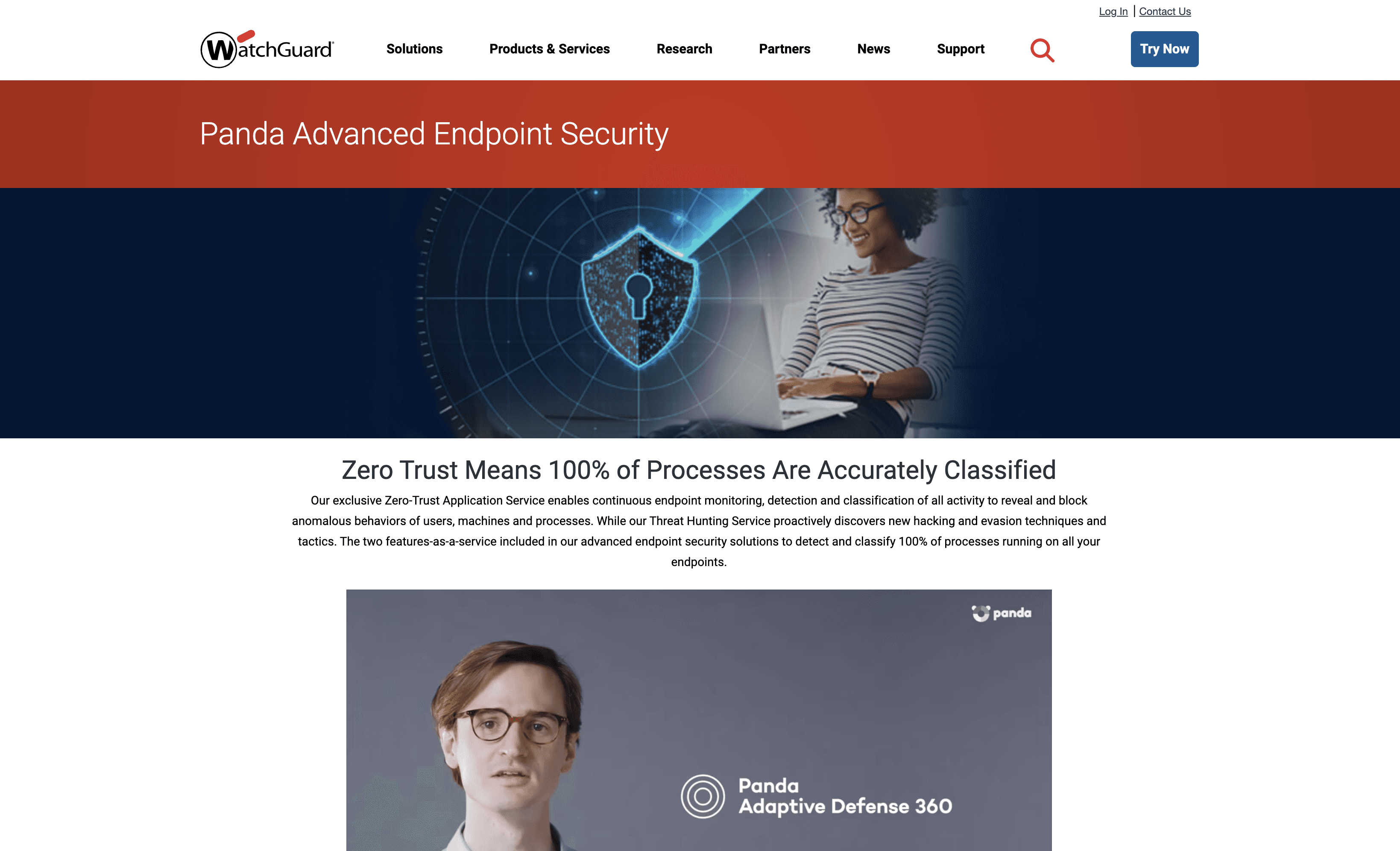
WatchGuard Panda Adaptive Defense 360 is a comprehensive cybersecurity solution that combines advanced endpoint protection with automated threat detection and response. It offers continuous monitoring, classification, and blocking of suspicious activities, ensuring robust security for businesses of all sizes. Easy to deploy and manage, it integrates seamlessly with existing systems.
WatchGuard Panda Adaptive Defense 360 Pricing
WatchGuard Panda Adaptive Defense 360's pricing is not public. Contact their support for more info.
WatchGuard Panda Adaptive Defense 360 Reviews
WatchGuard Panda Adaptive Defense 360 has an overall rating of 4.4 out of 5 stars based on 115 reviews. Users appreciate its comprehensive protection and ease of use. Check out more of our reviews here!
Pros and Cons of WatchGuard Panda Adaptive Defense 360
Pros:
Zero-Trust Application Service: Ensures 100% classification of processes, blocking any suspicious activity.
Comprehensive Protection: Combines EPP and EDR capabilities, providing a unified solution for endpoint security.
Automation: Reduces detection, response, and investigation time, enhancing overall efficiency.
Cons:
Complexity: The advanced features and comprehensive protection might require a steep learning curve for new users.
Resource Intensive: Continuous monitoring and AI-based classification might demand significant system resources.
Cost: Advanced security solutions with extensive features might come at a higher price point, which could be a consideration for smaller organizations.
4. Symantec
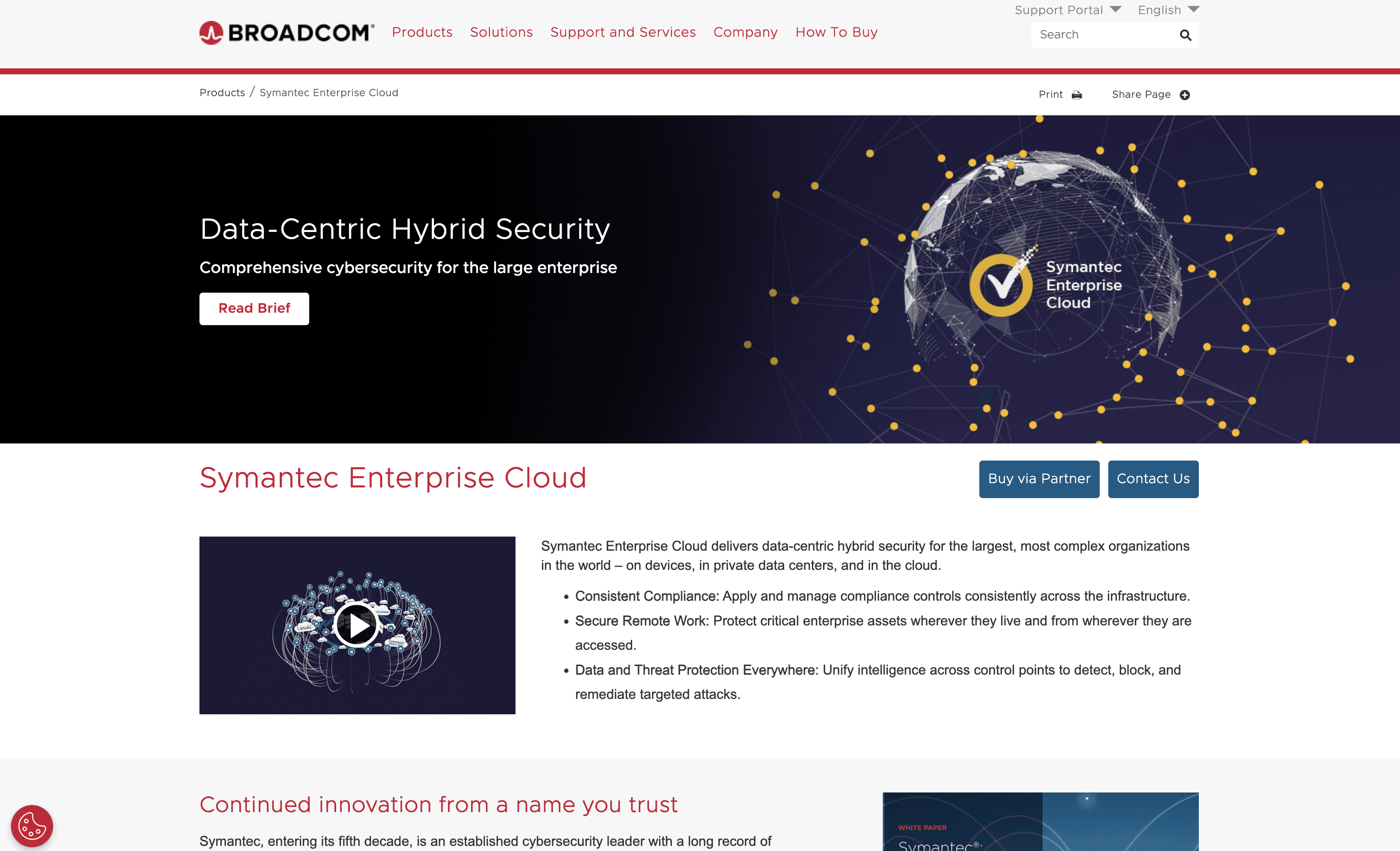
Symantec Enterprise Cloud is a comprehensive cybersecurity solution designed for large enterprises. It offers data-centric hybrid security, ensuring consistent compliance, secure remote work, and robust data and threat protection across devices, private data centers, and cloud environments. Symantec leverages AI to enhance security measures and simplify operations.
Symantec Pricing
Symantec's pricing is not public. Contact their support for more info.
Symantec Reviews
Symantec has an overall rating of 4.3 out of 5 stars based on 37 reviews. Users appreciate its robust protection and ease of use. Check out more of our reviews here!
Pros and Cons of Symantec
Pros:
Comprehensive Security: Symantec Enterprise Cloud offers robust protection across devices, private data centers, and the cloud.
Consistent Compliance: Easily manage compliance controls across the entire infrastructure, ensuring regulatory adherence.
AI Integration: Utilizes artificial intelligence to enhance threat detection and response, staying ahead of cyber threats.
Cons:
Complexity: The extensive features may be challenging to manage and implement for some organizations.
Cost: Designed for large enterprises, it may be expensive for smaller organizations with limited budgets.
Resource Intensive: Managing and maintaining the solution could require significant resources and expertise.
5. Forticlient
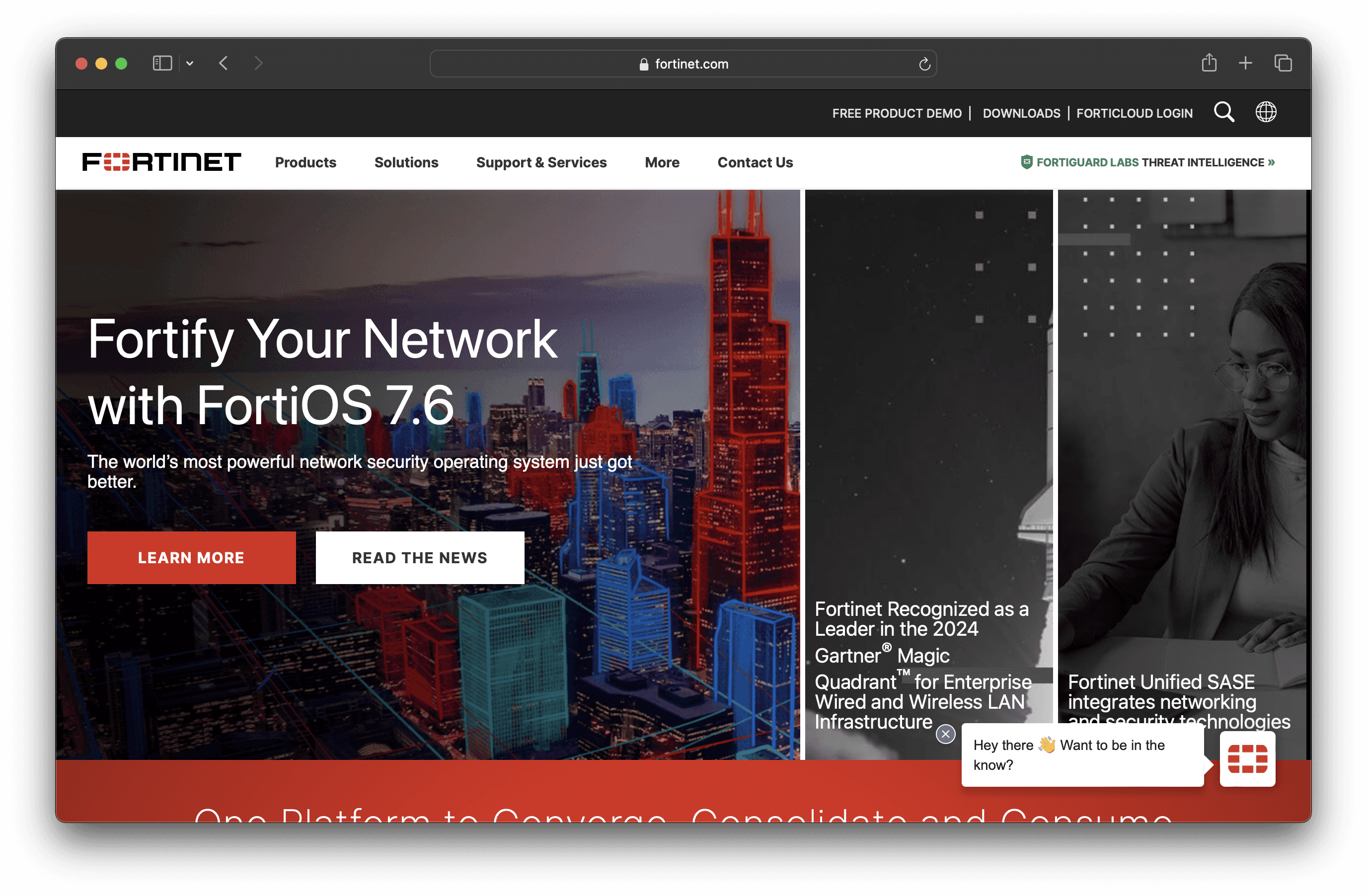
FortiClient is an endpoint security solution that offers comprehensive protection, compliance, and secure access. It integrates seamlessly with the Fortinet Security Fabric, providing telemetry and automated responses. Designed for ease of use, it supports centralized management and deployment, making it suitable for businesses of all sizes.
Forticlient Pricing
FortiClient's pricing is not public. Contact their support for more info.
Forticlient Reviews
FortiClient has an overall rating of 4.4 out of 5 stars based on 204 reviews. Users appreciate its ease of use and reliable connectivity. Check out more of our reviews here!
Pros and Cons of Forticlient
Pros:
Comprehensive Security: FortiClient offers endpoint protection, secure access, and advanced threat protection in a single, lightweight client.
Integration with Fortinet Security Fabric: Enhances visibility and control by integrating seamlessly with other Fortinet products.
AI-Based Capabilities: Includes AI-based antivirus, endpoint detection and response (EDR), and extended detection and response (XDR).
Cons:
Complexity for Small Organizations: Extensive features and integrations might overwhelm smaller organizations with limited IT resources.
Dependency on Fortinet Ecosystem: Full capabilities require investment in other Fortinet products, potentially increasing costs.
Learning Curve: Effective deployment and management require training and expertise, necessitating additional investment.
6. Acronis Cyber Protect Cloud
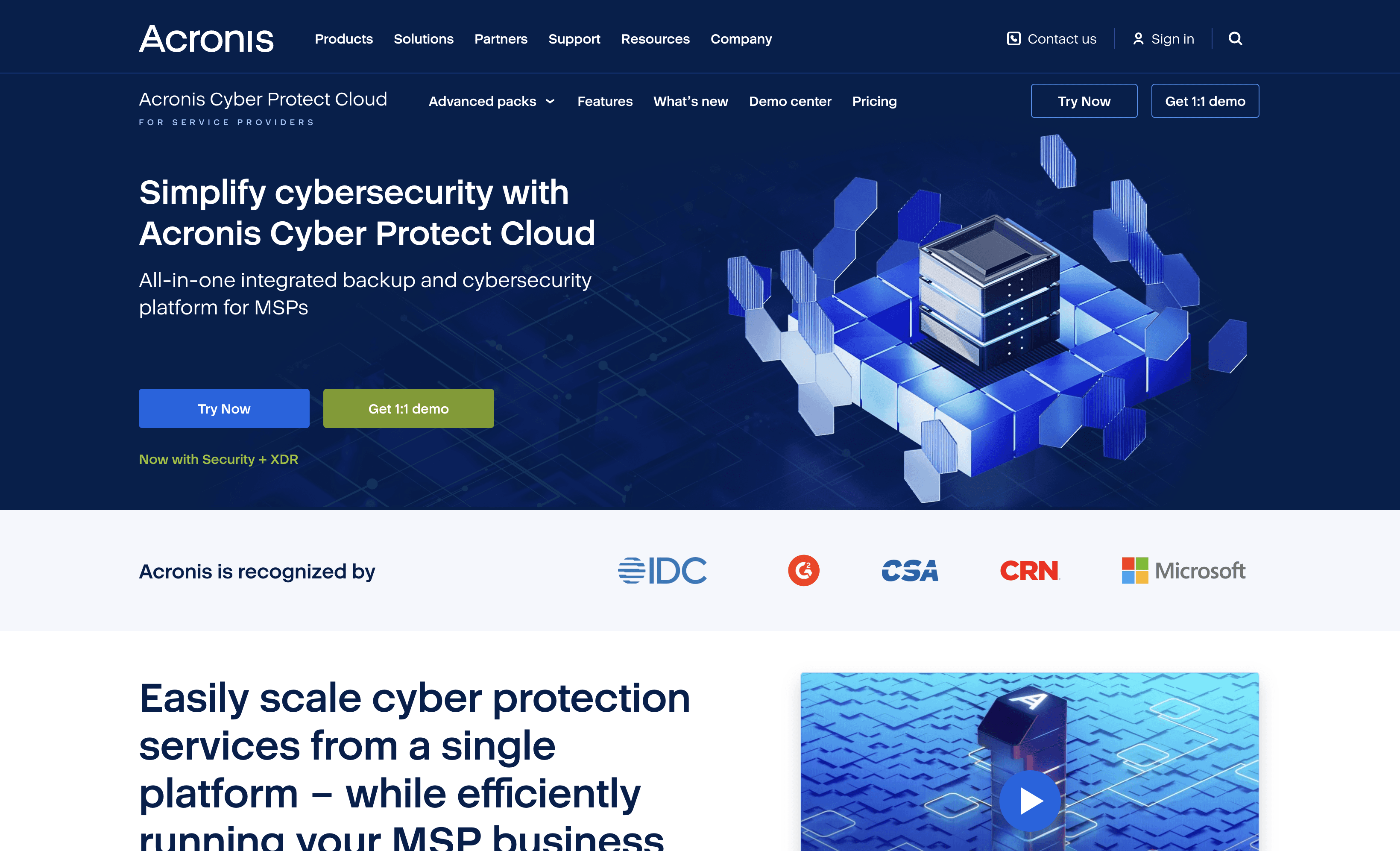
Acronis Cyber Protect Cloud is a comprehensive cyber protection solution designed for Managed Service Providers (MSPs). It integrates data protection, cybersecurity, and endpoint management into a single platform, simplifying operations and enhancing security. Easy to deploy and manage, it aims to reduce complexity and improve efficiency for MSPs.
Acronis Cyber Protect Cloud Pricing
Acronis Cyber Protect Cloud's pricing is not public. Contact their support for more info.
Acronis Cyber Protect Cloud Reviews
Acronis Cyber Protect Cloud has an overall rating of 4.7 out of 5 stars based on 975 reviews. Users appreciate its reliability and ease of administration. Check out more of our reviews here!
Pros and Cons of Acronis Cyber Protect Cloud
Pros:
Reduces complexity and allows control over services delivered to customers, including security, backup, disaster recovery, endpoint management, and automation.
Consolidates multiple vendors, increasing efficiency and reducing costs, risks, and operational overhead.
Provides a single console for efficient management and monitoring of clients, enhancing control over cyber protection.
Cons:
The extensive features and integrations might be overwhelming for smaller MSPs with limited resources.
Heavy reliance on Acronis' ecosystem and tools might limit flexibility in choosing other vendors or solutions.
The initial setup and configuration might require significant effort and expertise, especially for MSPs new to Acronis products.
7. Bitdefender GravityZone Business Security
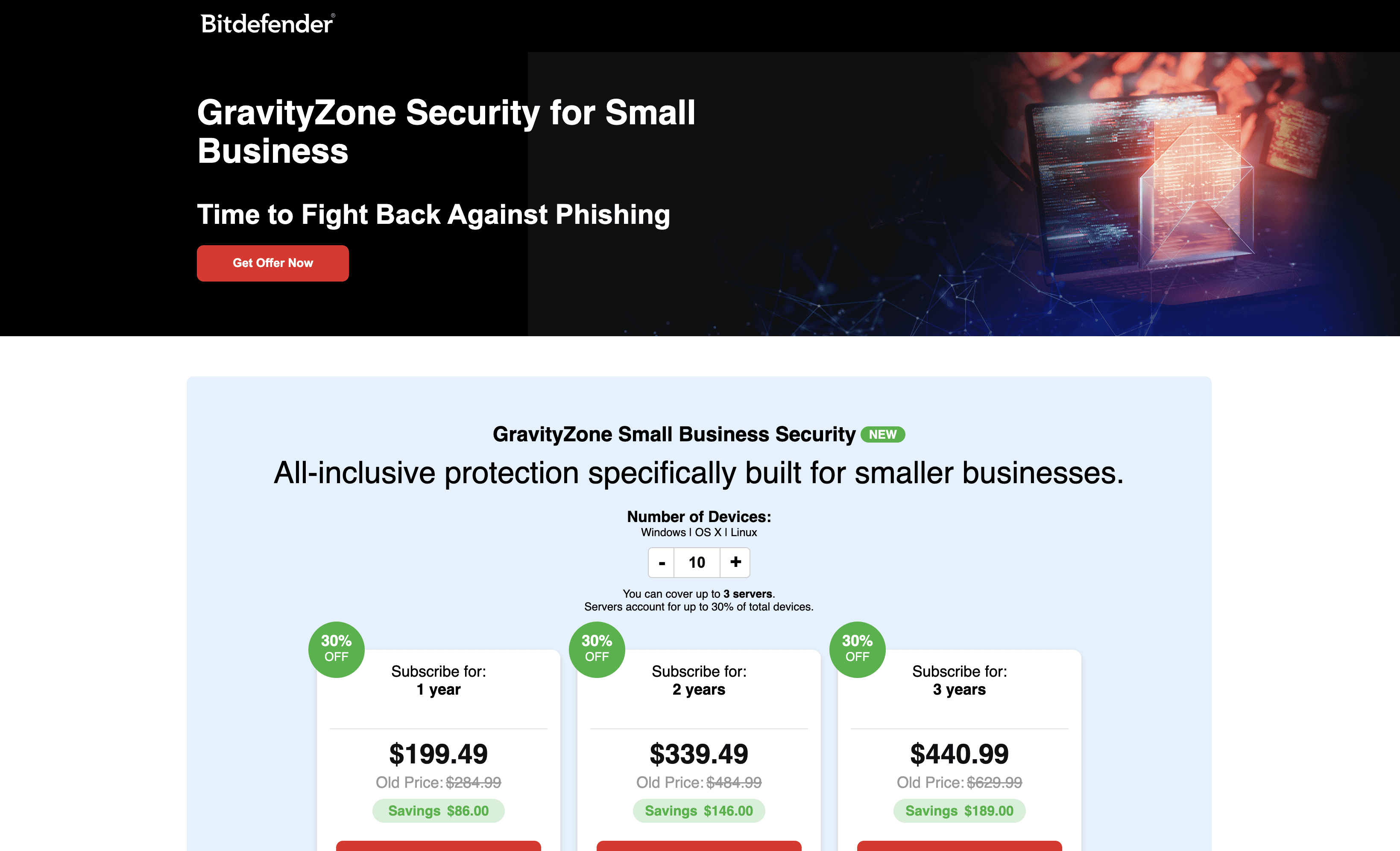
Bitdefender GravityZone Business Security is a comprehensive cybersecurity solution designed for small businesses. It offers robust protection against malware, ransomware, and phishing attacks. Easy to deploy and manage, it ensures continuous security without overwhelming system resources, making it ideal for businesses with limited IT expertise.
Bitdefender GravityZone Business Security Pricing
1 Year Subscription: $199.49
2 Years Subscription: $339.49
3 Years Subscription: $440.99
Bitdefender GravityZone Business Security Reviews
Bitdefender GravityZone Business Security has an overall rating of 4.0 out of 5 stars based on 65 reviews. Users appreciate its ease of navigation and effective threat detection. Check out more of our reviews here!
Pros and Cons of Bitdefender GravityZone Business Security
Pros:
Effective Anti-Phishing: Blocks known phishing pages and provides adaptive defense, ensuring robust protection against phishing attacks.
Ransomware Protection: Multiple layers of defense against ransomware, including monitoring and blocking malicious processes.
Single Console for Easy Management: Simplifies security management with a unified solution for all security needs.
Cons:
Complex Interface: Despite its features, the interface can be challenging to navigate for non-IT users.
Additional Costs for Add-Ons: Enhancing security with add-ons incurs extra costs, potentially increasing the overall expense.
Potential Complexity for Non-IT Users: Initial setup and configuration might be difficult without IT knowledge, despite claims of simplicity.
8. Cylance
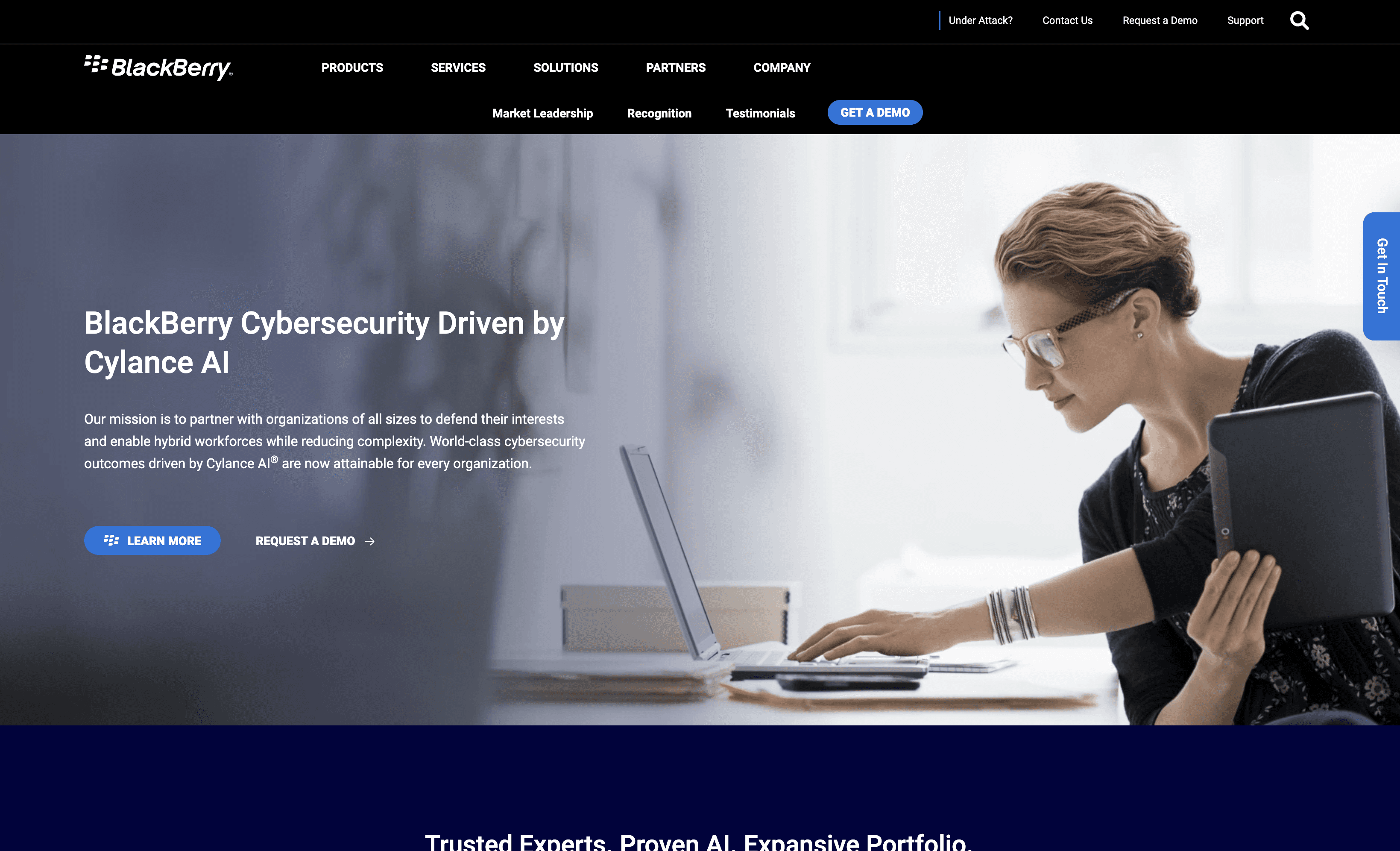
Cylance is an AI-driven cybersecurity solution designed to protect endpoints from zero-day attacks and sophisticated threats. It offers managed detection and response, zero trust network access, and ransomware protection. Cylance aims to simplify security management while providing robust protection for businesses of all sizes.
Cylance Pricing
CylanceMDR
CylanceENDPOINT
CylanceEDGE
BlackBerry UEM
Cylance's pricing is not public. Contact their support for more info.
Cylance Reviews
Cylance has an overall rating of 4.3 out of 5 stars based on 57 reviews. Users appreciate its lightweight nature and effective AI-driven protection. Check out more of our reviews here!
Pros and Cons of Cylance
Pros:
High Efficacy Ratings: Cylance AI-driven solutions deliver some of the highest efficacy ratings in the market.
Low CPU Utilization: Uses up to 20x less CPU utilization, even without an internet connection, compared to other solutions.
Broad, Integrated Controls: Solutions span network, endpoint, and cloud, providing a resilient defense for any-sized organization.
Cons:
Initial Training Period: Requires a training period to adapt to the environment, which might need initial effort and time.
Dependency on AI: Heavy reliance on AI might concern organizations preferring traditional, human-driven cybersecurity approaches.
Cost Considerations: Initial investment in AI-driven solutions might be significant for smaller organizations, despite long-term savings.
9. Cisco Secure Endpoint

Cisco Secure Endpoint is a cloud-native solution designed to provide advanced endpoint security. It focuses on quick detection, response, and recovery from attacks, aiming to reduce remediation times significantly. With features like EDR, XDR, and threat hunting, it offers robust protection for businesses of all sizes.
Cisco Secure Endpoint Pricing
Cisco Secure Endpoint's pricing is not public. Contact their support for more info.
Cisco Secure Endpoint Reviews
Cisco Secure Endpoint has an overall rating of 4.5 out of 5 stars based on 21 reviews. Users appreciate its ease of use and deployment. Check out more of our reviews here!
Pros and Cons of Cisco Secure Endpoint
Pros:
Powerful EDR Capabilities: Built-in endpoint detection and response, threat hunting, and risk-based vulnerability management.
Streamlined Investigations: Quick answers about endpoints with Orbital Advanced Search capability.
Integrated XDR Capabilities: Unified view, simplified incident management, and automated playbooks with the SecureX platform.
Cons:
Compatibility Issues: Some users report problems with software compatibility across different operating systems.
Inaccurate Information: Occasional inaccuracies in threat detection data can lead to false positives.
Limitations: Certain advanced features may require additional configuration and expertise.
10. Absolute Secure Endpoint
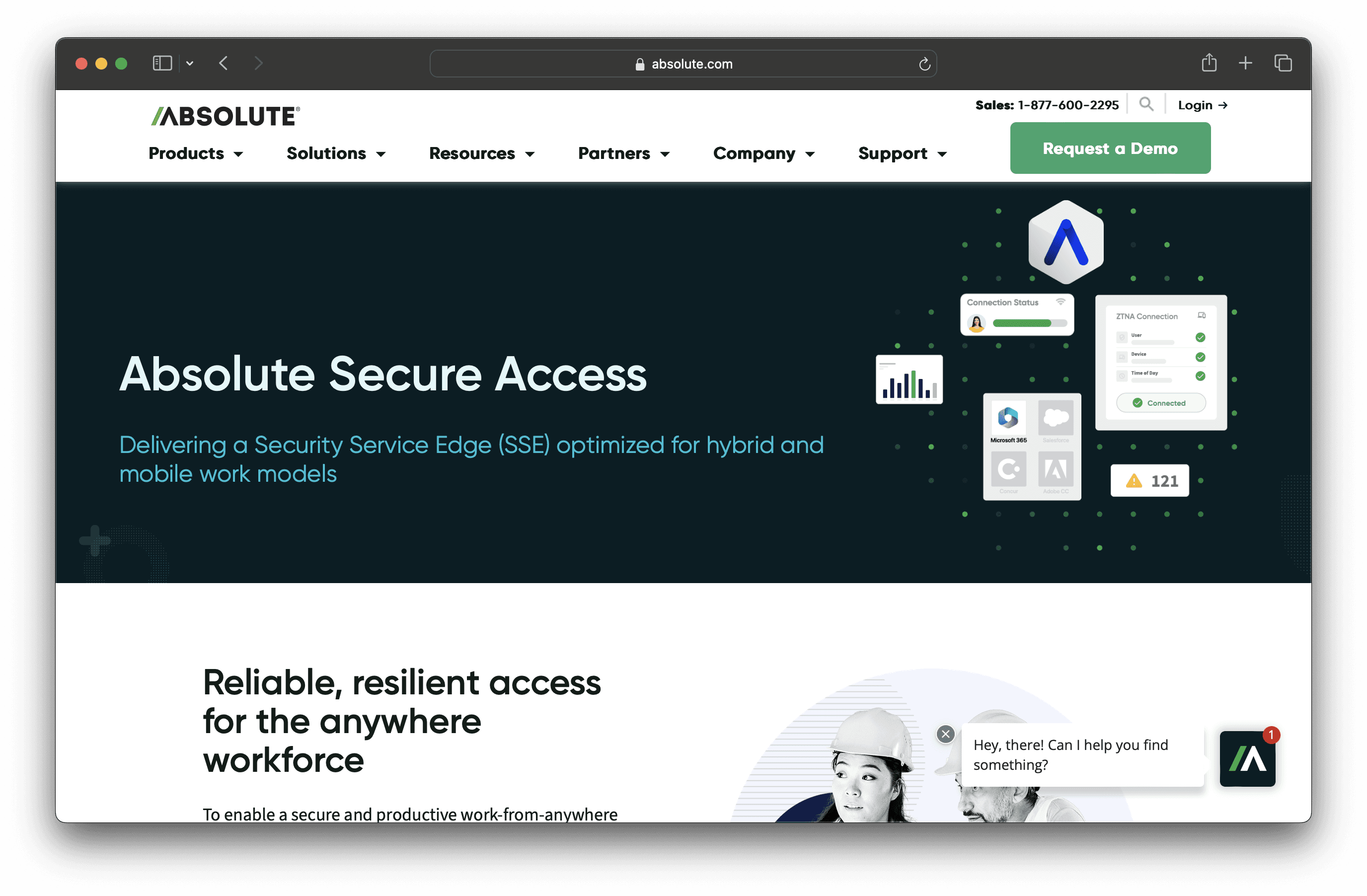
Absolute Secure Endpoint is a cybersecurity solution designed to provide comprehensive protection for devices and data. It offers features like device tracking, remote data deletion, and application self-healing. With a focus on ease of use and robust security, it aims to safeguard businesses of all sizes.
Absolute Secure Endpoint Pricing
Absolute Visibility
Absolute Control
Absolute Resilience
Absolute Secure Endpoint's pricing is not public. Contact their support for more info.
Absolute Secure Endpoint Reviews
Absolute Secure Endpoint has an overall rating of 4.6 out of 5 stars based on 307 reviews. Users appreciate its robust security features and ease of use. Check out more of our reviews here!
Pros and Cons of Absolute Secure Endpoint
Pros:
Comprehensive Device Tracking: Tracks device location and status, providing detailed reports and alerts for enhanced security.
Ease of Use: User-friendly interface simplifies management and monitoring, making it accessible for non-technical users.
Robust Security Features: Offers advanced protection, including remote data deletion and application self-healing, ensuring data integrity.
Cons:
Compatibility Issues: Some features are limited to specific operating systems, affecting overall functionality.
Limited Features in Basic Packages: Advanced features are only available in higher-tier packages, potentially increasing costs.
Geographic Restrictions: Certain services, like stolen device recovery, are limited to specific regions, reducing global applicability.
Looking to secure your technical infrastructure?
Twingate offers granular access controls and deployment automations to protect your VPC environment. By leveraging Zero Trust security tools, Twingate ensures that private resources and internet traffic remain secure in the modern work landscape. Try Twingate for Free today!
Rapidly implement a modern Zero Trust network that is more secure and maintainable than VPNs.
The Best 10 Alternatives to Threatlocker (+ Pricing & Reviews)
Twingate Team
•
Jul 27, 2024

ThreatLocker offers a Zero Trust Endpoint Protection Platform that includes application allowlisting, ringfencing, network control, and storage control. While ThreatLocker provides robust cybersecurity solutions, it may not be suitable for every organization. This article explores how Twingate enhances secure access for distributed workforces.

10 Alternatives to Threatlocker
1. Vipre EDR

Vipre Endpoint Detection and Response (EDR) is a cybersecurity solution designed to efficiently stop threats and provide comprehensive protection. It emphasizes simplicity and power, offering award-winning security for everyday challenges. Vipre EDR is easy to install and use, making it accessible for businesses of all sizes.
Vipre EDR Pricing
Vipre EDR's pricing is not public. Contact their support for more info.
Vipre EDR Reviews
Vipre EDR has an overall rating of 4.5 out of 5 stars based on 200 reviews. Users appreciate its ease of use and robust protection. Check out more of our reviews here!
Pros and Cons of Vipre EDR
Pros:
VIPRE EDR is easy to install and use, making it accessible for businesses of all sizes.
It offers robust ransomware prevention and rollback, utilizing real-time behavior monitoring and AI.
Provides a complete view of threat behavior, enabling rapid remediation and centralized monitoring.
Cons:
Limited user reviews make it difficult to gauge overall customer satisfaction and performance.
Some features are only available on higher-tier plans, potentially increasing costs for full functionality.
While powerful, the product may require additional training for optimal use by non-experts.
2. Huntress Managed EDR

Huntress Managed EDR is a cybersecurity solution tailored for small and medium-sized businesses. It offers comprehensive endpoint detection and response, ensuring full visibility and rapid threat mitigation. With 24/7 SOC support and smart filtering technology, Huntress aims to provide robust security without overwhelming system resources.
Huntress Managed EDR Pricing
Huntress Managed EDR's pricing is not public. Contact their support for more info.
Huntress Managed EDR Reviews
Huntress Managed EDR has an overall rating of 4.9 out of 5 stars based on 663 reviews. Users appreciate its ease of use and effective threat detection. Check out more of our reviews here!
Pros and Cons ofHuntress Managed EDR
Pros:
Full visibility, detection, and response for endpoints, ensuring comprehensive security.
Rapid deployment, providing quick protection for small and medium-sized businesses.
24/7 support from expert analysts in a Security Operations Center (SOC).
Cons:
Specific pricing information is not provided, which could be a concern for budget-conscious SMBs.
Integration with existing IT infrastructure might pose challenges for some businesses.
Effectiveness may depend on the quality of endpoint data and IT team responsiveness.
3. WatchGuard Panda Adaptive Defense 360

WatchGuard Panda Adaptive Defense 360 is a comprehensive cybersecurity solution that combines advanced endpoint protection with automated threat detection and response. It offers continuous monitoring, classification, and blocking of suspicious activities, ensuring robust security for businesses of all sizes. Easy to deploy and manage, it integrates seamlessly with existing systems.
WatchGuard Panda Adaptive Defense 360 Pricing
WatchGuard Panda Adaptive Defense 360's pricing is not public. Contact their support for more info.
WatchGuard Panda Adaptive Defense 360 Reviews
WatchGuard Panda Adaptive Defense 360 has an overall rating of 4.4 out of 5 stars based on 115 reviews. Users appreciate its comprehensive protection and ease of use. Check out more of our reviews here!
Pros and Cons of WatchGuard Panda Adaptive Defense 360
Pros:
Zero-Trust Application Service: Ensures 100% classification of processes, blocking any suspicious activity.
Comprehensive Protection: Combines EPP and EDR capabilities, providing a unified solution for endpoint security.
Automation: Reduces detection, response, and investigation time, enhancing overall efficiency.
Cons:
Complexity: The advanced features and comprehensive protection might require a steep learning curve for new users.
Resource Intensive: Continuous monitoring and AI-based classification might demand significant system resources.
Cost: Advanced security solutions with extensive features might come at a higher price point, which could be a consideration for smaller organizations.
4. Symantec

Symantec Enterprise Cloud is a comprehensive cybersecurity solution designed for large enterprises. It offers data-centric hybrid security, ensuring consistent compliance, secure remote work, and robust data and threat protection across devices, private data centers, and cloud environments. Symantec leverages AI to enhance security measures and simplify operations.
Symantec Pricing
Symantec's pricing is not public. Contact their support for more info.
Symantec Reviews
Symantec has an overall rating of 4.3 out of 5 stars based on 37 reviews. Users appreciate its robust protection and ease of use. Check out more of our reviews here!
Pros and Cons of Symantec
Pros:
Comprehensive Security: Symantec Enterprise Cloud offers robust protection across devices, private data centers, and the cloud.
Consistent Compliance: Easily manage compliance controls across the entire infrastructure, ensuring regulatory adherence.
AI Integration: Utilizes artificial intelligence to enhance threat detection and response, staying ahead of cyber threats.
Cons:
Complexity: The extensive features may be challenging to manage and implement for some organizations.
Cost: Designed for large enterprises, it may be expensive for smaller organizations with limited budgets.
Resource Intensive: Managing and maintaining the solution could require significant resources and expertise.
5. Forticlient

FortiClient is an endpoint security solution that offers comprehensive protection, compliance, and secure access. It integrates seamlessly with the Fortinet Security Fabric, providing telemetry and automated responses. Designed for ease of use, it supports centralized management and deployment, making it suitable for businesses of all sizes.
Forticlient Pricing
FortiClient's pricing is not public. Contact their support for more info.
Forticlient Reviews
FortiClient has an overall rating of 4.4 out of 5 stars based on 204 reviews. Users appreciate its ease of use and reliable connectivity. Check out more of our reviews here!
Pros and Cons of Forticlient
Pros:
Comprehensive Security: FortiClient offers endpoint protection, secure access, and advanced threat protection in a single, lightweight client.
Integration with Fortinet Security Fabric: Enhances visibility and control by integrating seamlessly with other Fortinet products.
AI-Based Capabilities: Includes AI-based antivirus, endpoint detection and response (EDR), and extended detection and response (XDR).
Cons:
Complexity for Small Organizations: Extensive features and integrations might overwhelm smaller organizations with limited IT resources.
Dependency on Fortinet Ecosystem: Full capabilities require investment in other Fortinet products, potentially increasing costs.
Learning Curve: Effective deployment and management require training and expertise, necessitating additional investment.
6. Acronis Cyber Protect Cloud

Acronis Cyber Protect Cloud is a comprehensive cyber protection solution designed for Managed Service Providers (MSPs). It integrates data protection, cybersecurity, and endpoint management into a single platform, simplifying operations and enhancing security. Easy to deploy and manage, it aims to reduce complexity and improve efficiency for MSPs.
Acronis Cyber Protect Cloud Pricing
Acronis Cyber Protect Cloud's pricing is not public. Contact their support for more info.
Acronis Cyber Protect Cloud Reviews
Acronis Cyber Protect Cloud has an overall rating of 4.7 out of 5 stars based on 975 reviews. Users appreciate its reliability and ease of administration. Check out more of our reviews here!
Pros and Cons of Acronis Cyber Protect Cloud
Pros:
Reduces complexity and allows control over services delivered to customers, including security, backup, disaster recovery, endpoint management, and automation.
Consolidates multiple vendors, increasing efficiency and reducing costs, risks, and operational overhead.
Provides a single console for efficient management and monitoring of clients, enhancing control over cyber protection.
Cons:
The extensive features and integrations might be overwhelming for smaller MSPs with limited resources.
Heavy reliance on Acronis' ecosystem and tools might limit flexibility in choosing other vendors or solutions.
The initial setup and configuration might require significant effort and expertise, especially for MSPs new to Acronis products.
7. Bitdefender GravityZone Business Security

Bitdefender GravityZone Business Security is a comprehensive cybersecurity solution designed for small businesses. It offers robust protection against malware, ransomware, and phishing attacks. Easy to deploy and manage, it ensures continuous security without overwhelming system resources, making it ideal for businesses with limited IT expertise.
Bitdefender GravityZone Business Security Pricing
1 Year Subscription: $199.49
2 Years Subscription: $339.49
3 Years Subscription: $440.99
Bitdefender GravityZone Business Security Reviews
Bitdefender GravityZone Business Security has an overall rating of 4.0 out of 5 stars based on 65 reviews. Users appreciate its ease of navigation and effective threat detection. Check out more of our reviews here!
Pros and Cons of Bitdefender GravityZone Business Security
Pros:
Effective Anti-Phishing: Blocks known phishing pages and provides adaptive defense, ensuring robust protection against phishing attacks.
Ransomware Protection: Multiple layers of defense against ransomware, including monitoring and blocking malicious processes.
Single Console for Easy Management: Simplifies security management with a unified solution for all security needs.
Cons:
Complex Interface: Despite its features, the interface can be challenging to navigate for non-IT users.
Additional Costs for Add-Ons: Enhancing security with add-ons incurs extra costs, potentially increasing the overall expense.
Potential Complexity for Non-IT Users: Initial setup and configuration might be difficult without IT knowledge, despite claims of simplicity.
8. Cylance

Cylance is an AI-driven cybersecurity solution designed to protect endpoints from zero-day attacks and sophisticated threats. It offers managed detection and response, zero trust network access, and ransomware protection. Cylance aims to simplify security management while providing robust protection for businesses of all sizes.
Cylance Pricing
CylanceMDR
CylanceENDPOINT
CylanceEDGE
BlackBerry UEM
Cylance's pricing is not public. Contact their support for more info.
Cylance Reviews
Cylance has an overall rating of 4.3 out of 5 stars based on 57 reviews. Users appreciate its lightweight nature and effective AI-driven protection. Check out more of our reviews here!
Pros and Cons of Cylance
Pros:
High Efficacy Ratings: Cylance AI-driven solutions deliver some of the highest efficacy ratings in the market.
Low CPU Utilization: Uses up to 20x less CPU utilization, even without an internet connection, compared to other solutions.
Broad, Integrated Controls: Solutions span network, endpoint, and cloud, providing a resilient defense for any-sized organization.
Cons:
Initial Training Period: Requires a training period to adapt to the environment, which might need initial effort and time.
Dependency on AI: Heavy reliance on AI might concern organizations preferring traditional, human-driven cybersecurity approaches.
Cost Considerations: Initial investment in AI-driven solutions might be significant for smaller organizations, despite long-term savings.
9. Cisco Secure Endpoint

Cisco Secure Endpoint is a cloud-native solution designed to provide advanced endpoint security. It focuses on quick detection, response, and recovery from attacks, aiming to reduce remediation times significantly. With features like EDR, XDR, and threat hunting, it offers robust protection for businesses of all sizes.
Cisco Secure Endpoint Pricing
Cisco Secure Endpoint's pricing is not public. Contact their support for more info.
Cisco Secure Endpoint Reviews
Cisco Secure Endpoint has an overall rating of 4.5 out of 5 stars based on 21 reviews. Users appreciate its ease of use and deployment. Check out more of our reviews here!
Pros and Cons of Cisco Secure Endpoint
Pros:
Powerful EDR Capabilities: Built-in endpoint detection and response, threat hunting, and risk-based vulnerability management.
Streamlined Investigations: Quick answers about endpoints with Orbital Advanced Search capability.
Integrated XDR Capabilities: Unified view, simplified incident management, and automated playbooks with the SecureX platform.
Cons:
Compatibility Issues: Some users report problems with software compatibility across different operating systems.
Inaccurate Information: Occasional inaccuracies in threat detection data can lead to false positives.
Limitations: Certain advanced features may require additional configuration and expertise.
10. Absolute Secure Endpoint

Absolute Secure Endpoint is a cybersecurity solution designed to provide comprehensive protection for devices and data. It offers features like device tracking, remote data deletion, and application self-healing. With a focus on ease of use and robust security, it aims to safeguard businesses of all sizes.
Absolute Secure Endpoint Pricing
Absolute Visibility
Absolute Control
Absolute Resilience
Absolute Secure Endpoint's pricing is not public. Contact their support for more info.
Absolute Secure Endpoint Reviews
Absolute Secure Endpoint has an overall rating of 4.6 out of 5 stars based on 307 reviews. Users appreciate its robust security features and ease of use. Check out more of our reviews here!
Pros and Cons of Absolute Secure Endpoint
Pros:
Comprehensive Device Tracking: Tracks device location and status, providing detailed reports and alerts for enhanced security.
Ease of Use: User-friendly interface simplifies management and monitoring, making it accessible for non-technical users.
Robust Security Features: Offers advanced protection, including remote data deletion and application self-healing, ensuring data integrity.
Cons:
Compatibility Issues: Some features are limited to specific operating systems, affecting overall functionality.
Limited Features in Basic Packages: Advanced features are only available in higher-tier packages, potentially increasing costs.
Geographic Restrictions: Certain services, like stolen device recovery, are limited to specific regions, reducing global applicability.
Looking to secure your technical infrastructure?
Twingate offers granular access controls and deployment automations to protect your VPC environment. By leveraging Zero Trust security tools, Twingate ensures that private resources and internet traffic remain secure in the modern work landscape. Try Twingate for Free today!
Rapidly implement a modern Zero Trust network that is more secure and maintainable than VPNs.
The Best 10 Alternatives to Threatlocker (+ Pricing & Reviews)
Twingate Team
•
Jul 27, 2024

ThreatLocker offers a Zero Trust Endpoint Protection Platform that includes application allowlisting, ringfencing, network control, and storage control. While ThreatLocker provides robust cybersecurity solutions, it may not be suitable for every organization. This article explores how Twingate enhances secure access for distributed workforces.

10 Alternatives to Threatlocker
1. Vipre EDR

Vipre Endpoint Detection and Response (EDR) is a cybersecurity solution designed to efficiently stop threats and provide comprehensive protection. It emphasizes simplicity and power, offering award-winning security for everyday challenges. Vipre EDR is easy to install and use, making it accessible for businesses of all sizes.
Vipre EDR Pricing
Vipre EDR's pricing is not public. Contact their support for more info.
Vipre EDR Reviews
Vipre EDR has an overall rating of 4.5 out of 5 stars based on 200 reviews. Users appreciate its ease of use and robust protection. Check out more of our reviews here!
Pros and Cons of Vipre EDR
Pros:
VIPRE EDR is easy to install and use, making it accessible for businesses of all sizes.
It offers robust ransomware prevention and rollback, utilizing real-time behavior monitoring and AI.
Provides a complete view of threat behavior, enabling rapid remediation and centralized monitoring.
Cons:
Limited user reviews make it difficult to gauge overall customer satisfaction and performance.
Some features are only available on higher-tier plans, potentially increasing costs for full functionality.
While powerful, the product may require additional training for optimal use by non-experts.
2. Huntress Managed EDR

Huntress Managed EDR is a cybersecurity solution tailored for small and medium-sized businesses. It offers comprehensive endpoint detection and response, ensuring full visibility and rapid threat mitigation. With 24/7 SOC support and smart filtering technology, Huntress aims to provide robust security without overwhelming system resources.
Huntress Managed EDR Pricing
Huntress Managed EDR's pricing is not public. Contact their support for more info.
Huntress Managed EDR Reviews
Huntress Managed EDR has an overall rating of 4.9 out of 5 stars based on 663 reviews. Users appreciate its ease of use and effective threat detection. Check out more of our reviews here!
Pros and Cons ofHuntress Managed EDR
Pros:
Full visibility, detection, and response for endpoints, ensuring comprehensive security.
Rapid deployment, providing quick protection for small and medium-sized businesses.
24/7 support from expert analysts in a Security Operations Center (SOC).
Cons:
Specific pricing information is not provided, which could be a concern for budget-conscious SMBs.
Integration with existing IT infrastructure might pose challenges for some businesses.
Effectiveness may depend on the quality of endpoint data and IT team responsiveness.
3. WatchGuard Panda Adaptive Defense 360

WatchGuard Panda Adaptive Defense 360 is a comprehensive cybersecurity solution that combines advanced endpoint protection with automated threat detection and response. It offers continuous monitoring, classification, and blocking of suspicious activities, ensuring robust security for businesses of all sizes. Easy to deploy and manage, it integrates seamlessly with existing systems.
WatchGuard Panda Adaptive Defense 360 Pricing
WatchGuard Panda Adaptive Defense 360's pricing is not public. Contact their support for more info.
WatchGuard Panda Adaptive Defense 360 Reviews
WatchGuard Panda Adaptive Defense 360 has an overall rating of 4.4 out of 5 stars based on 115 reviews. Users appreciate its comprehensive protection and ease of use. Check out more of our reviews here!
Pros and Cons of WatchGuard Panda Adaptive Defense 360
Pros:
Zero-Trust Application Service: Ensures 100% classification of processes, blocking any suspicious activity.
Comprehensive Protection: Combines EPP and EDR capabilities, providing a unified solution for endpoint security.
Automation: Reduces detection, response, and investigation time, enhancing overall efficiency.
Cons:
Complexity: The advanced features and comprehensive protection might require a steep learning curve for new users.
Resource Intensive: Continuous monitoring and AI-based classification might demand significant system resources.
Cost: Advanced security solutions with extensive features might come at a higher price point, which could be a consideration for smaller organizations.
4. Symantec

Symantec Enterprise Cloud is a comprehensive cybersecurity solution designed for large enterprises. It offers data-centric hybrid security, ensuring consistent compliance, secure remote work, and robust data and threat protection across devices, private data centers, and cloud environments. Symantec leverages AI to enhance security measures and simplify operations.
Symantec Pricing
Symantec's pricing is not public. Contact their support for more info.
Symantec Reviews
Symantec has an overall rating of 4.3 out of 5 stars based on 37 reviews. Users appreciate its robust protection and ease of use. Check out more of our reviews here!
Pros and Cons of Symantec
Pros:
Comprehensive Security: Symantec Enterprise Cloud offers robust protection across devices, private data centers, and the cloud.
Consistent Compliance: Easily manage compliance controls across the entire infrastructure, ensuring regulatory adherence.
AI Integration: Utilizes artificial intelligence to enhance threat detection and response, staying ahead of cyber threats.
Cons:
Complexity: The extensive features may be challenging to manage and implement for some organizations.
Cost: Designed for large enterprises, it may be expensive for smaller organizations with limited budgets.
Resource Intensive: Managing and maintaining the solution could require significant resources and expertise.
5. Forticlient

FortiClient is an endpoint security solution that offers comprehensive protection, compliance, and secure access. It integrates seamlessly with the Fortinet Security Fabric, providing telemetry and automated responses. Designed for ease of use, it supports centralized management and deployment, making it suitable for businesses of all sizes.
Forticlient Pricing
FortiClient's pricing is not public. Contact their support for more info.
Forticlient Reviews
FortiClient has an overall rating of 4.4 out of 5 stars based on 204 reviews. Users appreciate its ease of use and reliable connectivity. Check out more of our reviews here!
Pros and Cons of Forticlient
Pros:
Comprehensive Security: FortiClient offers endpoint protection, secure access, and advanced threat protection in a single, lightweight client.
Integration with Fortinet Security Fabric: Enhances visibility and control by integrating seamlessly with other Fortinet products.
AI-Based Capabilities: Includes AI-based antivirus, endpoint detection and response (EDR), and extended detection and response (XDR).
Cons:
Complexity for Small Organizations: Extensive features and integrations might overwhelm smaller organizations with limited IT resources.
Dependency on Fortinet Ecosystem: Full capabilities require investment in other Fortinet products, potentially increasing costs.
Learning Curve: Effective deployment and management require training and expertise, necessitating additional investment.
6. Acronis Cyber Protect Cloud

Acronis Cyber Protect Cloud is a comprehensive cyber protection solution designed for Managed Service Providers (MSPs). It integrates data protection, cybersecurity, and endpoint management into a single platform, simplifying operations and enhancing security. Easy to deploy and manage, it aims to reduce complexity and improve efficiency for MSPs.
Acronis Cyber Protect Cloud Pricing
Acronis Cyber Protect Cloud's pricing is not public. Contact their support for more info.
Acronis Cyber Protect Cloud Reviews
Acronis Cyber Protect Cloud has an overall rating of 4.7 out of 5 stars based on 975 reviews. Users appreciate its reliability and ease of administration. Check out more of our reviews here!
Pros and Cons of Acronis Cyber Protect Cloud
Pros:
Reduces complexity and allows control over services delivered to customers, including security, backup, disaster recovery, endpoint management, and automation.
Consolidates multiple vendors, increasing efficiency and reducing costs, risks, and operational overhead.
Provides a single console for efficient management and monitoring of clients, enhancing control over cyber protection.
Cons:
The extensive features and integrations might be overwhelming for smaller MSPs with limited resources.
Heavy reliance on Acronis' ecosystem and tools might limit flexibility in choosing other vendors or solutions.
The initial setup and configuration might require significant effort and expertise, especially for MSPs new to Acronis products.
7. Bitdefender GravityZone Business Security

Bitdefender GravityZone Business Security is a comprehensive cybersecurity solution designed for small businesses. It offers robust protection against malware, ransomware, and phishing attacks. Easy to deploy and manage, it ensures continuous security without overwhelming system resources, making it ideal for businesses with limited IT expertise.
Bitdefender GravityZone Business Security Pricing
1 Year Subscription: $199.49
2 Years Subscription: $339.49
3 Years Subscription: $440.99
Bitdefender GravityZone Business Security Reviews
Bitdefender GravityZone Business Security has an overall rating of 4.0 out of 5 stars based on 65 reviews. Users appreciate its ease of navigation and effective threat detection. Check out more of our reviews here!
Pros and Cons of Bitdefender GravityZone Business Security
Pros:
Effective Anti-Phishing: Blocks known phishing pages and provides adaptive defense, ensuring robust protection against phishing attacks.
Ransomware Protection: Multiple layers of defense against ransomware, including monitoring and blocking malicious processes.
Single Console for Easy Management: Simplifies security management with a unified solution for all security needs.
Cons:
Complex Interface: Despite its features, the interface can be challenging to navigate for non-IT users.
Additional Costs for Add-Ons: Enhancing security with add-ons incurs extra costs, potentially increasing the overall expense.
Potential Complexity for Non-IT Users: Initial setup and configuration might be difficult without IT knowledge, despite claims of simplicity.
8. Cylance

Cylance is an AI-driven cybersecurity solution designed to protect endpoints from zero-day attacks and sophisticated threats. It offers managed detection and response, zero trust network access, and ransomware protection. Cylance aims to simplify security management while providing robust protection for businesses of all sizes.
Cylance Pricing
CylanceMDR
CylanceENDPOINT
CylanceEDGE
BlackBerry UEM
Cylance's pricing is not public. Contact their support for more info.
Cylance Reviews
Cylance has an overall rating of 4.3 out of 5 stars based on 57 reviews. Users appreciate its lightweight nature and effective AI-driven protection. Check out more of our reviews here!
Pros and Cons of Cylance
Pros:
High Efficacy Ratings: Cylance AI-driven solutions deliver some of the highest efficacy ratings in the market.
Low CPU Utilization: Uses up to 20x less CPU utilization, even without an internet connection, compared to other solutions.
Broad, Integrated Controls: Solutions span network, endpoint, and cloud, providing a resilient defense for any-sized organization.
Cons:
Initial Training Period: Requires a training period to adapt to the environment, which might need initial effort and time.
Dependency on AI: Heavy reliance on AI might concern organizations preferring traditional, human-driven cybersecurity approaches.
Cost Considerations: Initial investment in AI-driven solutions might be significant for smaller organizations, despite long-term savings.
9. Cisco Secure Endpoint

Cisco Secure Endpoint is a cloud-native solution designed to provide advanced endpoint security. It focuses on quick detection, response, and recovery from attacks, aiming to reduce remediation times significantly. With features like EDR, XDR, and threat hunting, it offers robust protection for businesses of all sizes.
Cisco Secure Endpoint Pricing
Cisco Secure Endpoint's pricing is not public. Contact their support for more info.
Cisco Secure Endpoint Reviews
Cisco Secure Endpoint has an overall rating of 4.5 out of 5 stars based on 21 reviews. Users appreciate its ease of use and deployment. Check out more of our reviews here!
Pros and Cons of Cisco Secure Endpoint
Pros:
Powerful EDR Capabilities: Built-in endpoint detection and response, threat hunting, and risk-based vulnerability management.
Streamlined Investigations: Quick answers about endpoints with Orbital Advanced Search capability.
Integrated XDR Capabilities: Unified view, simplified incident management, and automated playbooks with the SecureX platform.
Cons:
Compatibility Issues: Some users report problems with software compatibility across different operating systems.
Inaccurate Information: Occasional inaccuracies in threat detection data can lead to false positives.
Limitations: Certain advanced features may require additional configuration and expertise.
10. Absolute Secure Endpoint

Absolute Secure Endpoint is a cybersecurity solution designed to provide comprehensive protection for devices and data. It offers features like device tracking, remote data deletion, and application self-healing. With a focus on ease of use and robust security, it aims to safeguard businesses of all sizes.
Absolute Secure Endpoint Pricing
Absolute Visibility
Absolute Control
Absolute Resilience
Absolute Secure Endpoint's pricing is not public. Contact their support for more info.
Absolute Secure Endpoint Reviews
Absolute Secure Endpoint has an overall rating of 4.6 out of 5 stars based on 307 reviews. Users appreciate its robust security features and ease of use. Check out more of our reviews here!
Pros and Cons of Absolute Secure Endpoint
Pros:
Comprehensive Device Tracking: Tracks device location and status, providing detailed reports and alerts for enhanced security.
Ease of Use: User-friendly interface simplifies management and monitoring, making it accessible for non-technical users.
Robust Security Features: Offers advanced protection, including remote data deletion and application self-healing, ensuring data integrity.
Cons:
Compatibility Issues: Some features are limited to specific operating systems, affecting overall functionality.
Limited Features in Basic Packages: Advanced features are only available in higher-tier packages, potentially increasing costs.
Geographic Restrictions: Certain services, like stolen device recovery, are limited to specific regions, reducing global applicability.
Looking to secure your technical infrastructure?
Twingate offers granular access controls and deployment automations to protect your VPC environment. By leveraging Zero Trust security tools, Twingate ensures that private resources and internet traffic remain secure in the modern work landscape. Try Twingate for Free today!
Solutions
Solutions
The VPN replacement your workforce will love.
Solutions